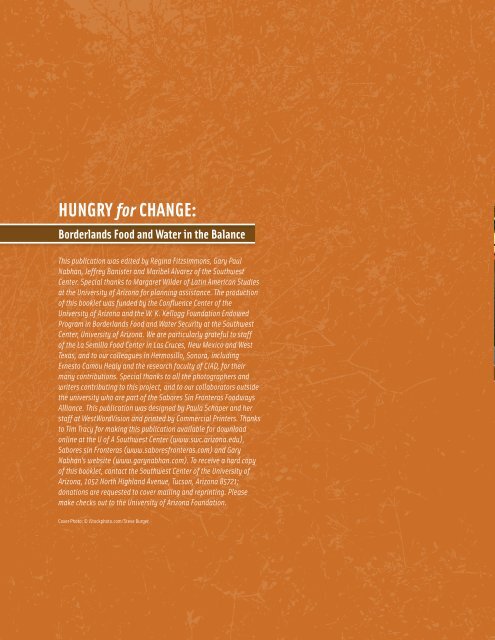Hungry for Change: Borderlands Food & Water in - Southwest ...
Hungry for Change: Borderlands Food & Water in - Southwest ...
Hungry for Change: Borderlands Food & Water in - Southwest ...
You also want an ePaper? Increase the reach of your titles
YUMPU automatically turns print PDFs into web optimized ePapers that Google loves.
<strong>Hungry</strong> <strong>for</strong> CHange:<br />
<strong>Borderlands</strong> <strong>Food</strong> and <strong>Water</strong> <strong>in</strong> the Balance<br />
This publication was edited by Reg<strong>in</strong>a Fitzsimmons, Gary Paul<br />
Nabhan, Jeffrey Banister and Maribel Alvarez of the <strong>Southwest</strong><br />
Center. Special thanks to Margaret Wilder of Lat<strong>in</strong> American Studies<br />
at the University of Arizona <strong>for</strong> plann<strong>in</strong>g assistance. The production<br />
of this booklet was funded by the Confluence Center of the<br />
University of Arizona and the W. K. Kellogg Foundation Endowed<br />
Program <strong>in</strong> <strong>Borderlands</strong> <strong>Food</strong> and <strong>Water</strong> Security at the <strong>Southwest</strong><br />
Center, University of Arizona. We are particularly grateful to staff<br />
of the La Semilla <strong>Food</strong> Center <strong>in</strong> Las Cruces, New Mexico and West<br />
Texas, and to our colleagues <strong>in</strong> Hermosillo, Sonora, <strong>in</strong>clud<strong>in</strong>g<br />
Ernesto Camou Healy and the research faculty of CIAD, <strong>for</strong> their<br />
many contributions. Special thanks to all the photographers and<br />
writers contribut<strong>in</strong>g to this project, and to our collaborators outside<br />
the university who are part of the Sabores S<strong>in</strong> Fronteras <strong>Food</strong>ways<br />
Alliance. This publication was designed by Paula Schaper and her<br />
staff at WestWordVision and pr<strong>in</strong>ted by Commercial Pr<strong>in</strong>ters. Thanks<br />
to Tim Tracy <strong>for</strong> mak<strong>in</strong>g this publication available <strong>for</strong> download<br />
onl<strong>in</strong>e at the U of A <strong>Southwest</strong> Center (www.swc.arizona.edu),<br />
Sabores s<strong>in</strong> Fronteras (www.saboresfronteras.com) and Gary<br />
Nabhan’s website (www.garynabhan.com). To receive a hard copy<br />
of this booklet, contact the <strong>Southwest</strong> Center of the University of<br />
Arizona, 1052 North Highland Avenue, Tucson, Arizona 85721;<br />
donations are requested to cover mail<strong>in</strong>g and repr<strong>in</strong>t<strong>in</strong>g. Please<br />
make checks out to the University of Arizona Foundation.<br />
Cover Photo: © iStockphoto.com/Steve Burger<br />
IntroductIon<br />
Gary Nabhan<br />
Maribel Alvarez<br />
Jeffrey Banister<br />
Reg<strong>in</strong>a Fitzsimmons<br />
<strong>Food</strong> grows our future: Child at a Sonoran hot dog cart <strong>in</strong> Tucson | Photo Michael Jones<br />
3<br />
Welcome to the food system of the U.S.-Mexico border<br />
—the geopolitical boundary with the greatest economic<br />
disparity <strong>in</strong> the world. Stories written and spoken about<br />
this unnatural rift <strong>in</strong> the landscape are the stuff of myth,<br />
literary leap<strong>in</strong>g or yarn sp<strong>in</strong>n<strong>in</strong>g, depend<strong>in</strong>g on who tells<br />
the tale. The U.S./Mexico border is also, <strong>for</strong> many, una<br />
herida abierta—an open wound. It’s a third country altogether;<br />
a ghostly apparition; America’s neglected playground;<br />
el Norte—where the grass is always greener (if it<br />
is alive at all), and so on.<br />
Researchers have gathered data to account <strong>for</strong> the economic<br />
and nutritional schism between the two countries.<br />
But the numbers are often imprecise, <strong>for</strong> Mexico<br />
and the United States rarely use the same measur<strong>in</strong>g<br />
stick. Accord<strong>in</strong>g to one report, the per capita <strong>in</strong>come of<br />
U.S. citizens ($45,989) is 5.6 times greater than that of<br />
Mexican citizens ($8,143), with most Americans hav<strong>in</strong>g at<br />
least three times the buy<strong>in</strong>g power <strong>for</strong> food and dr<strong>in</strong>k<br />
than their neighbors on the other side of the l<strong>in</strong>e.<br />
And yet, when we look more closely at the border<br />
region, we see that national averages hardly apply. In<br />
counties immediately adjacent to Mexico, poverty rates<br />
are twice as high as the rest of the U.S., while <strong>in</strong>comes <strong>in</strong><br />
Mexico’s northern border states are 75 percent greater<br />
than <strong>in</strong> the rest of the Republic. Nevertheless, this still<br />
puts the average <strong>in</strong>come <strong>in</strong> U.S. border counties far above<br />
the average <strong>in</strong>come <strong>in</strong> the Mexican border states.<br />
Such stark discrepancies become personal when<br />
Mexicans witness the lavish consumption and unbelievable<br />
waste of food (40-50 percent) by their neighbors<br />
north of the border. On economic grounds alone, it should<br />
be no surprise that there are at least five million undocumented<br />
Mexican-born residents <strong>in</strong> the United States,<br />
many of whom work <strong>in</strong> the farm, ranch and food service<br />
sectors of the economy.<br />
Meanwhile, 60 percent of all fresh w<strong>in</strong>ter-spr<strong>in</strong>g produce<br />
eaten <strong>in</strong> the U.S. now comes from Mexico. Wal-Mart<br />
is the largest s<strong>in</strong>gle food retailer <strong>in</strong> Mexico, provid<strong>in</strong>g<br />
more jobs than any other transnational corporation.<br />
Viewed from just about every angle, Mexico is critical to<br />
the U.S. food system, while the U.S. food system is <strong>in</strong>creas<strong>in</strong>gly<br />
important to Mexico.<br />
Given such differences and disparities <strong>in</strong> access to<br />
healthy food, we are surprised by the lack of a transborder<br />
food security and agricultural susta<strong>in</strong>ability


